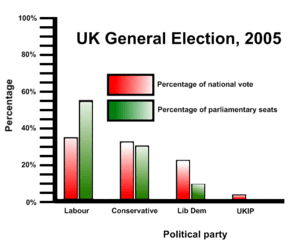Plurality voting facts for kids

Plurality voting is a way of choosing leaders or representatives in elections. It's used in countries like the United States and some others. In this system, voters pick just one person. The candidate who gets the most votes wins the election. It's that simple!
Contents
What is Plurality Voting?
Plurality voting means the person with the most votes wins. They don't need to get more than half of all the votes. They just need more votes than anyone else. Think of it like a race: the first person to cross the finish line wins, even if they didn't beat everyone by a lot.
How It Works
When you vote in a plurality system, you choose one candidate. After everyone votes, the votes are counted. The candidate who has the highest number of votes is declared the winner. It doesn't matter if another candidate was very close behind.
Why Parties Use Primary Elections
Sometimes, a political party might have many people who want to run for the same job. To make sure their votes aren't split, parties often hold a "primary election." This helps them choose just one strong candidate to represent their party in the main election.
Here's an example: Imagine 100 voters. Let's say 60 of them usually vote for Party A, and 40 vote for Party B. If two candidates from Party A run against one candidate from Party B in the main election:
- Candidate A1 (Party A) gets 30 votes.
- Candidate A2 (Party A) gets 30 votes.
- Candidate B1 (Party B) gets 40 votes.
Even though 60 people preferred Party A overall, Candidate B1 wins with 40 votes. This is because 40 was the highest number of votes any single candidate received. Primary elections help avoid this kind of split.
Voting for a "Compromise" Candidate
When there are more than two candidates, voters sometimes choose someone they think has a real chance of winning. This is called "compromise voting." They might not pick their absolute favorite. Instead, they pick someone they like who also seems likely to win. This is because they want to make sure a candidate they really dislike doesn't win.
Good Points and Bad Points
Like any system, plurality voting has its fans and its critics.
Arguments Against Plurality Voting
Some people argue that this system gives too much power to news organizations. They say the media can influence who people think are the "front runners." This might make voters feel like they can only choose between two main candidates. Critics also worry that voting for a smaller, "third" candidate might accidentally help the candidate you like the least. This is because your vote for the third candidate doesn't go to one of the main two. It's also possible that the two main candidates might not truly represent what most people want.
Arguments For Plurality Voting
Supporters of plurality voting say it's very simple to understand. It's easy to count the votes and declare a winner. They also believe it encourages voters to choose a candidate who appeals to a wider range of people. This can lead to more moderate leaders.
Run-off Elections
To fix some of the problems, some elections use a "run-off election." This happens if no candidate gets a certain percentage of votes, like a majority (more than half). If that happens, the top two candidates have another election. This ensures the winner has stronger support.

